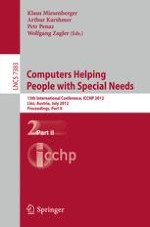The two-volume set LNCS 7382 and 7383 constiutes the refereed proceedings of the 13th International Conference on Computers Helping People with Special Needs, ICCHP 2012, held in Linz, Austria, in July 2012. The 147 revised full papers and 42 short papers were carefully reviewed and selected from 364 submissions. The papers included in the second volume are organized in the following topical sections: portable and mobile systems in assistive technology; assistive technology, HCI and rehabilitation; sign 2.0: ICT for sign language users: information sharing, interoperability, user-centered design and collaboration; computer-assisted augmentative and alternative communication; easy to Web between science of education, information design and speech technology; smart and assistive environments: ambient assisted living; text entry for accessible computing; tactile graphics and models for blind people and recognition of shapes by touch; mobility for blind and partially sighted people; and human-computer interaction for blind and partially sighted people.
